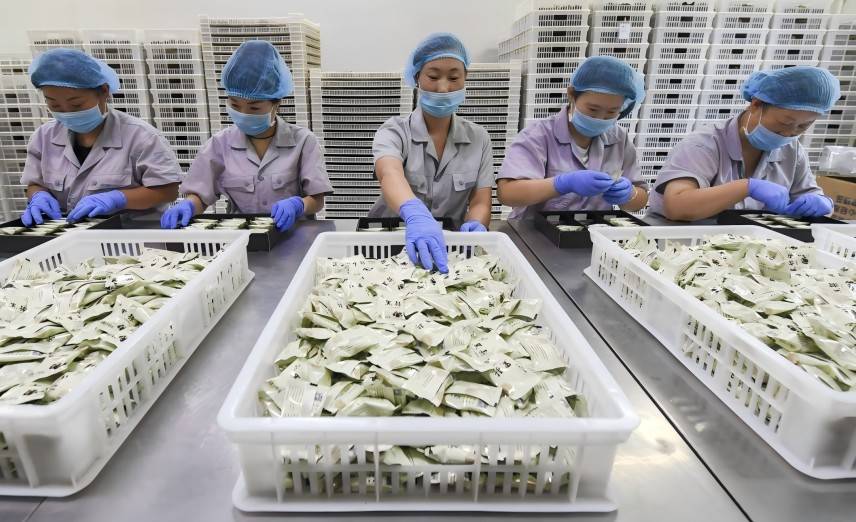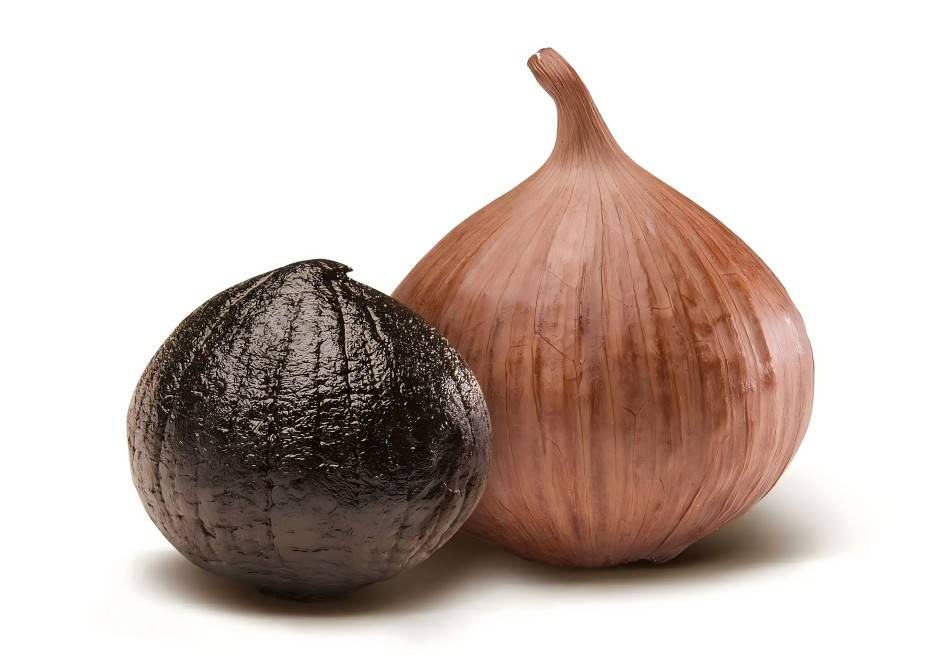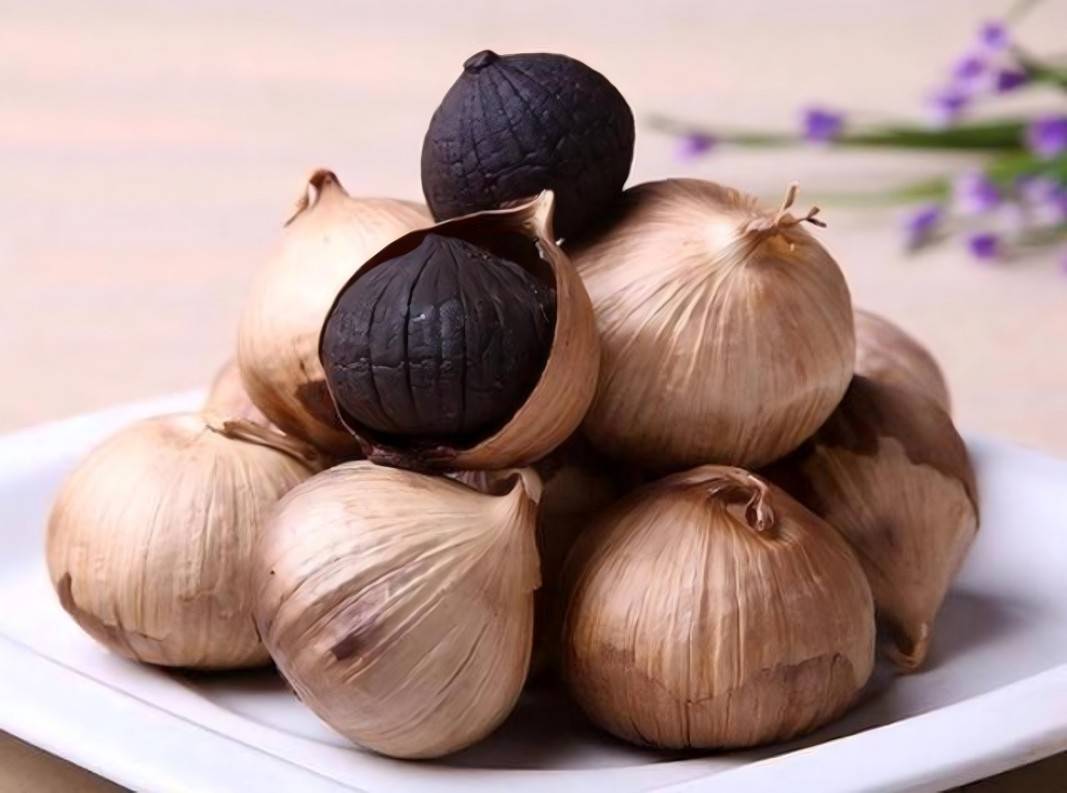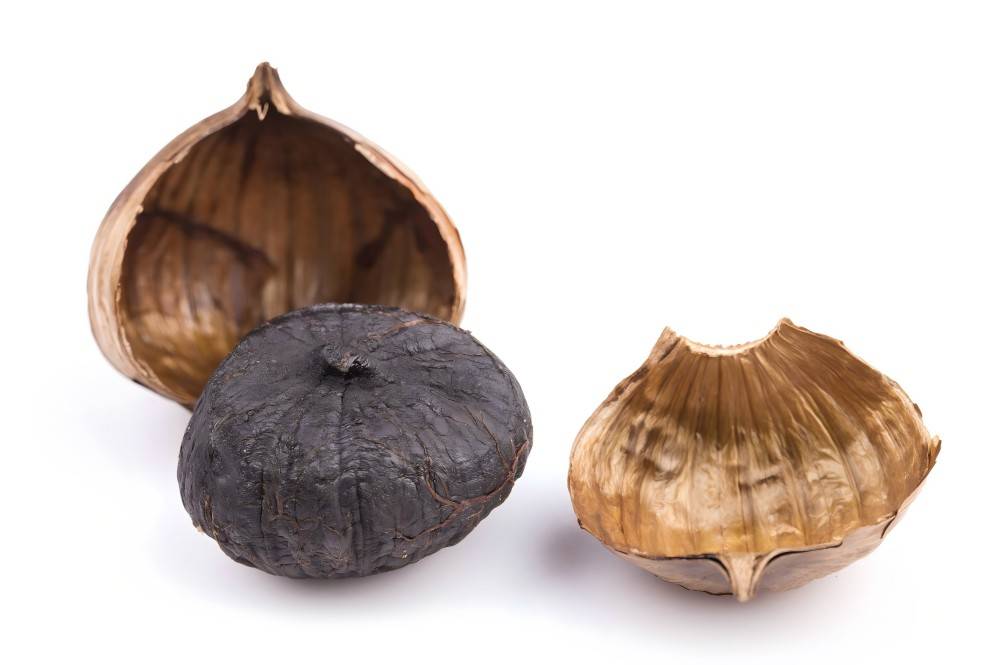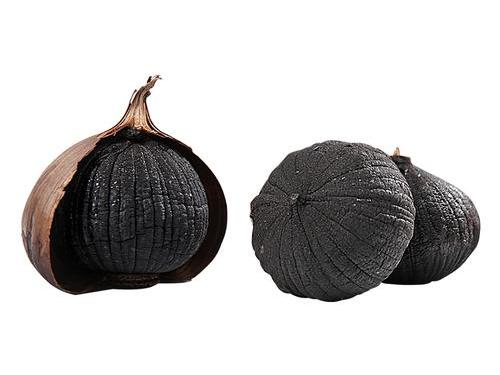What Are the Healthy Benefits of Black Garlic?
1 Overview
Black garlic, also known as black garlic or fermented black garlic, is a new type of garlic product made from fresh garlic by successively cleaning, enzyming, maturing and drying [1]. The processing of black garlic involves enzymatic reactions and non-enzymatic browning reactions, including the Maillard reaction, caramelization reaction, and Vc oxidative decomposition [2]. Because the garlic cloves turn black after fermentation, they are called black garlic. Currently, the majority of garlic consumed in China is raw or in primary processed form, with low added value, which has affected the development of the garlic industry[3]. Black garlic is a new high-end product developed by Japanese scholar Kiyohiko Kitamura in 2007, which has caused a craze in the garlic processing industry[4].
Black garlic is soft and sweet, without the pungent taste and unpleasant smell of raw garlic. Compared with white garlic, black garlic contains a variety of active ingredients and trace elements[5], including at least twice as much protein, sugar and vitamins, and black garlic SOD activity is more than 10 times higher than fresh garlic, and the content of polyphenols is more than 5 times higher[6]. After fermentation, black garlic has enhanced functions such as anti-oxidation, lowering blood lipids, and anti-tumor [7]. Compared with fresh garlic before the Maillard reaction, black garlic has more application prospects. Therefore, this paper provides a comprehensive summary of the health benefits, processing technology, and further processed products of black garlic, with the aim of providing a reference for the innovation of black garlic production processes, the in-depth development of garlic products, and the industrial development of the industry.
2 Main chemical components of black garlic
Black garlic undergoes enzymatic hydrolysis, ripening, drying and other processes, which increase the content of its original substances and generate new functional substances.
Carbohydrates: During the processing of black garlic, the polysaccharides are broken down into monosaccharides and disaccharides due to enzymatic hydrolysis by amylase and other enzymes and the thermal effect of the maturing process. The content of reducing sugars (mainly glucose and fructose) in black garlic accounts for more than 60% of the dry weight[8], which is dozens of times higher than that in fresh garlic.
Free amino acids: During the fermentation process, a large amount of the protein in raw garlic is converted into the 18 essential amino acids for the human body[9]. Therefore, in addition to all the amino acids in fresh garlic, the content of free amino acids in black garlic is also increased.
Polyphenols: Polyphenols in black garlic are an important component of its functional characteristics. When fresh garlic is processed into black garlic, the polyphenol content increases by more than 5 times[10]. This may be because during the heating process, the macromolecules in the polyphenols in black garlic are hydrolyzed to produce small molecules, releasing more phenolic hydroxyl groups and increasing the total antioxidant capacity of black garlic.
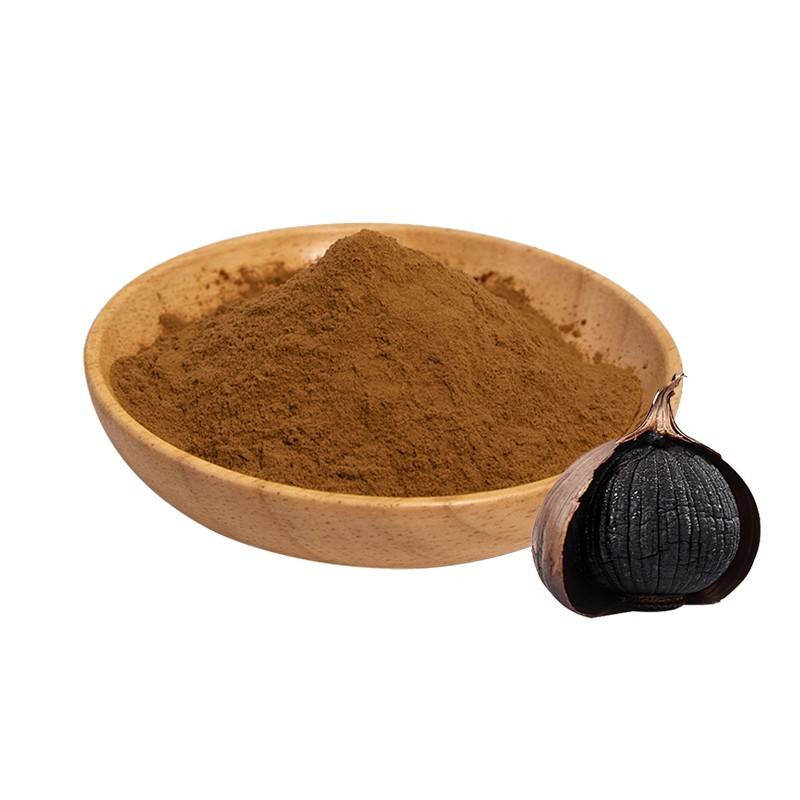
Melanin-like substances: During the browning process, black garlic undergoes a Maillard reaction, and its black color is mainly due to the protein melanin, a product of the Maillard reaction. Tressl et al. [11] proposed that melanin-like polymeric substances are composed of pyrrole or furan and formed by polycondensation and the Maillard reaction. Hofmann [12] believes that low molecular weight chromophores are formed by the cross-linking reaction of lysine ε-NH2 or arginine with proteins to form high molecular weight chromophores. Cammerer [13] believes that they are formed by the Maillard reaction in the first stage of the Maillard reaction, the products of sugar degradation are formed by Aldol condensation and polymerization.
Sulfur-containing compounds: The sulfur-containing compounds unique to black garlic are the main bioactive substances. The content is 4 times that of vegetables with high organic sulfur compounds such as onions and cabbages, and can effectively inhibit tumors. There are ten main types of sulfur compounds in black garlic, which can be divided into fat-soluble and water-soluble. They include S-dipropyl disulfide, 3,3-dithio-1-propene, diallyl disulfide monoxide, 1-methyl-2-propyl disulfide-3-methoxyhexane, diallyl tetrasulfide, diallyl disulfide, diallyl trisulfide, methyl allyl sulfide, ethylene dithiocarbamate, diallyl thiosulfate[14]. During the processing of black garlic, the cells are damaged, and under the catalytic action of alliinase, alliin in the vacuole and alliin in the cytoplasm produce allicin. However, allicin is unstable and can be converted into diallyl disulfide and diallyl trisulfide [15].
3 Health benefits of black garlic
Black garlic contains a variety of chemical components that give it better health benefits. Black garlic has antioxidant, antibacterial, anti-inflammatory, antitumor, and immune-enhancing health benefits. Sasaki et al. compared and analyzed the composition of black garlic and ordinary garlic, and the results showed that the content of water-soluble sulfide compounds in black garlic was eight times that of ordinary garlic, and black garlic had significant antioxidant, antitumor, antibacterial and anti-inflammatory, and immune-enhancing functions. Sato et al. [16] found that black garlic can effectively prevent diabetes and kidney disease.
3.1 Antioxidant effect
Black garlic retains some of the nutrients in garlic, and the polyphenol content of black garlic is much higher than that of ordinary garlic [17]. Oxidative reactions and free radical damage can cause DNA damage in cells, leading to cell malignancy. The sulfhydryl and electrophilic groups contained in black garlic have the function of scavenging active oxygen and free radicals. Zhu Bingqiao et al. [18] studied the antioxidant activity of black garlic.
Animal experiments on mice showed that black garlic can reduce the levels of malondialdehyde in the blood and liver, and significantly increase the activity of antioxidant enzymes, with significantly better results than white garlic. Zhou Guangyong et al. [19] studied the changes in the free radical scavenging capacity of black garlic during storage. The study found that the free radical scavenging capacity of black garlic was more than 8 times that of fresh garlic, and the maximum value of free radical scavenging capacity could reach 69 g Trolox/kg-dry matter. Lei Mengmeng[20] experiments show that compared with the model group, black garlic increases the time to death by half, the average and maximum life expectancy, SOD and CAT activity, and reduces MDA content in Drosophila. Liu Ruishan et al. [21] found that the scavenging rate of the black garlic extract for DPPH free radicals was 92.65%, so black garlic has good antioxidant activity.
3.2 Bactericidal and anti-inflammatory effects
Garlic is considered a “broad-spectrum antibiotic” with significant antibacterial properties. Studies have shown[22] that fermented black garlic has a significant inhibitory effect on gram-positive and gram-negative bacteria, salmonella, staphylococcus, etc. Yang Jiasheng [23] showed that allicin can kill Helicobacter pylori, prevent the occurrence of gastric ulcers and gastritis, and has a good therapeutic effect on gastric ulcers. Li Yan et al. [24] used black garlic extract in combination with cefazolin or gentamicin to investigate the inhibitory effect of black garlic on Staphylococcus aureus and Escherichia coli. The results showed that the MIC of black garlic extract against Staphylococcus aureus and Escherichia coli was 256 μg/mL. When black garlic extract was used in combination with cefazolin or gentamicin, the MIC of the antibiotics against Staphylococcus aureus and Escherichia coli was significantly reduced, showing additive and synergistic effects.
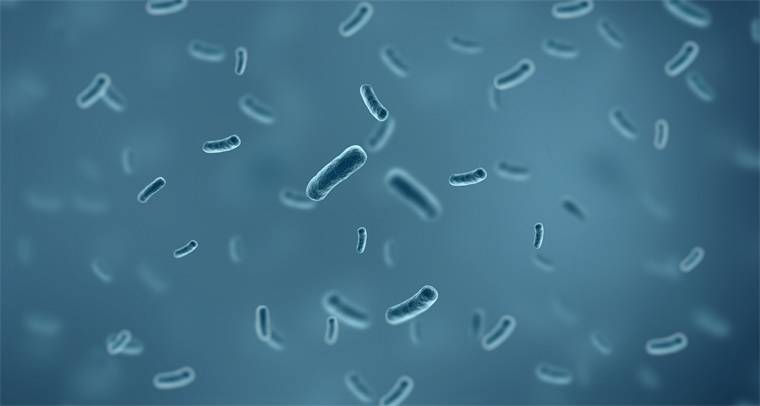
3.3 Antitumor effect
Ethyl ethyl sulfide and diallyl trisulfide in black garlic can prevent the formation and accumulation of nitrosamines in the stomach. Studies have shown [25] that allicin can increase the permeability of tumor cells and damage cell membranes. Allicin can damage cell nuclei, cause chromosomal disintegration, and overflow nuclear material, leading to the death of tumor cells. At the same time, black garlic can block the synthesis of carcinogens such as nitrosamines, inhibit the growth of cancer cells, and kill cancer cells. Wu Shaoxiong et al. [26] applied allicin to mouse bladder tumors to study its anti-tumor effect and mechanism. He used an MTT assay to investigate the direct cytotoxic activity of allicin, and the results showed that allicin has a significant anti-tumor effect.
3.4 Immune-enhancing effect
The fat-soluble volatile oil in black garlic can significantly enhance the phagocytic function of macrophages, and has an immune-enhancing effect. Allicin can enhance the body's immune system and induce human lymphocytes. Once the concentration of allicin increases, the activity frequency of lymphocytes also increases; and allicin affects the phagocytosis and killing of neutrophils to varying degrees [27]. Cho et al. [28] found that black garlic can prevent the apoptosis of macrophages in the abdominal cavity under hypoxic conditions and enhance the function of macrophages. Therefore, compared with ordinary garlic, black garlic has more application prospects.
4 Processing technology and deep-processed products of black garlic
4.1 Processing technology of black garlic
Japanese researchers have developed black garlic products and a series of deep-processed black garlic products through years of research [29]. China's black garlic processing technology was mainly introduced from Japan, with some differences in specific processing. At present, black garlic processing technology includes solid-state and liquid fermentation, as well as non-fermentation high temperature and high pressure methods. Fermentation is the more commonly used method.
An important part of solid-state fermentation is high-temperature, high-humidity fermentation, which is the basis for the garlic's own melanoid reaction. Yang Xia [30] proposed a constant temperature and humidity fermentation method, in which the garlic is placed in a clean fermentation workshop, heated to 50-80 °C, humidified to 50%-80%, and fermented for one month to make black garlic. Luo Cangxue et al. [31] used a liquid black garlic fermentation process. The garlic cloves were crushed, and the liquid-to-material ratio was 2:1. The crushed garlic was fermented in a vacuum sealed container with a particle size of 4 mm. Black garlic products have a uniform color, an increased total phenol content and SOD activity, and the fermentation time is shortened to 16–19 days. Although this fermentation method is easy to operate and control, it consumes a lot of energy and is not very efficient.
In order to shorten the fermentation time, save costs, and increase the content of effective ingredients, the domestic production of black garlic often uses a variable temperature fermentation method. Anton [32] used a three-stage variable temperature fermentation method to produce black garlic. Experiments showed that variable temperature fermentation is beneficial to improving the sensory quality of black garlic products, shortening processing time, and saving energy. Wang Haisu et al. [33] used a combination of -18 ℃ low-temperature freezing pretreatment and variable temperature fermentation to develop black garlic, and then compared the quality of three commercially available traditionally fermented black garlic. The results showed that the sensory and nutritional qualities, including reducing sugars, total phenols, free amino acids, and volatile active substance content, were comparable to or better than those of commercially available traditionally fermented black garlic, while shortening the fermentation cycle of black garlic.
The solid-state fermentation and liquid fermentation methods are complex, some of which require lactic acid or garlic essential oil, which are complicated to operate, have high product costs, long fermentation cycles, and low production efficiency. Zhao Yan et al. [34] used a non-fermented high-temperature high-pressure method to develop non-fermented black garlic. He removed impurities from the garlic and placed it in a pressure steam sterilizer, where it was steamed at 130 °C for 1 h. Non-fermented black garlic is rich in amino acids, has a high total phenol content, and a high scavenging rate for DPPH free radicals. This black garlic processing technology is simple and feasible, with a short processing time and low cost consumption. It is a better direction for garlic processing.
4.2 Deep-processed black garlic products
Black garlic has extremely high nutritional and medicinal value, but there are few deep-processed black garlic products in China. They are usually eaten fresh or used in cooking. Simple black garlic products can no longer meet market requirements, and the development of a wide range of deep-processed black garlic products is a major trend. Black garlic is a product of the Maillard reaction of garlic. Black garlic processed into fruit leather can exert its good health-care functions and at the same time meet consumer demand for functional foods. Wang Weidong et al. [35] studied the formula and baking process of black garlic fruit leather. When the ratio of black garlic, apples and carrots is 3:2:1, the fruit leather contains 1.2% pectin, 0.6% citric acid and 25% white sugar, and is dried by blast drying at 70 °C for 10 h or vacuum drying at 50 °C for 8 h. 2%, citric acid 0.6%, and white sugar 25%, and dried by blast drying at 70 °C for 10 h or vacuum drying at 50 °C for 8 h. The resulting fruit peel has the best sensory quality, and the total phenol content of the fruit peel is higher, and the quality is better.
Black garlic processed into black garlic powder, low moisture content, long shelf life, good solubility. Black garlic powder can be eaten directly or used as a raw material for further processed products. Zhang Peiqi et al. [36] prepared black garlic powder using the spray drying method. When the black garlic liquid contains 18% soluble solids and 6% β-cyclodextrin, the inlet temperature is 210 °C, the feed flow rate is 28 mL/min, and the black garlic powder has good solubility and a strong aroma.
Research on black garlic paste using black garlic as the raw material can enrich the variety of black garlic products. At the same time, it can make the best use of black garlic with incomplete skin or poor color, reduce economic losses, and achieve value-added garlic. Zhang Min et al. [37] experimented and obtained that when the optimal formula for black garlic sauce is black garlic pulp addition: sugar solution addition: pectin addition: citric acid addition is 100: 100: 0.18: 0.6 (mass ratio), the end point of black garlic sauce concentration is 50% soluble solid content, and the sensory quality of the prepared black garlic sauce is better. Acetic acid volatility affects human olfaction. 18 ∶ 0 . 6 (mass ratio). The end point of the black garlic sauce concentration is a soluble solid content of 50%, and the black garlic sauce obtained has good sensory quality.
Acetic acid volatilization has a stimulating effect on the human sense of smell, and also has the functions of softening blood vessels, lowering blood pressure, and lowering blood lipids[ 38] . Dong Yan et al. [39] used peeled black garlic cloves as raw material, vinegar to extract the nutrients, and used the extract to prepare black garlic vinegar drinks. The results showed that 1 kg of black garlic was extracted with 10 L of vinegar for 8 h. The extract had a good color and a rich aroma. The best black garlic vinegar drink was prepared from 40 mL of black garlic vinegar extract, 2. 0 g, and 1.0 g of white sugar. Li et al. [40] studied the process and formula for the compounding of black garlic and xylo-oligosaccharides to produce a compound black garlic laxative functional beverage. This compound black garlic beverage has a good laxative effect and improves the intestinal flora of mice.
In recent years, foreign companies have begun to pay attention to black garlic products, and products such as black garlic heads, black garlic tablets, black garlic dried fruit, black garlic puree, and black garlic capsules have also been successively launched on the market[41]. A wide variety of black garlic deep-processing products have enriched the black garlic market and promoted the development of the garlic industry.
5 Discussion
Black garlic is a material with high nutritional and medicinal value, and its application fields are becoming wider and wider. However, black garlic production and processing have just started in China and are still in the infancy of the industry. Processing technology is imported from abroad, the production cycle is long, the price is high, product quality is difficult to control, and many of the pharmacological effects of black garlic are still unknown, which all require further research and exploration. At the same time, a single black garlic product can no longer meet people's needs, and a compound black garlic product with food therapy and health care functions will emerge.
References:
[1] Lei Fengchao, Hao Guo, Zhu Li, et al. Research progress on the nutritional value and health benefits of black garlic [J]. Food Industry Science and Technology, 2012, 33(13): 429-432.
[2] Bu Liwei, Qiu Ruixia, Huang Xuesong. Separation and identification of the coloring substance 5-hydroxymethylfurfural in black garlic and its kinetic of formation [J]. Food and Fermentation Industry, 2014, 40 (3): 36-40.
[3] Bian Maokai, Wang Cuiying. Garlic market analysis and outlook [J]. Agricultural Products Processing, 2011(5): 14-15.
[4] Liu Yufeng, Ji Yanru, Shi Jie, et al. Study on the change law of main nutrients during black garlic processing [J]. Chinese Condiments, 2014, 39(9): 52-56.
[5] Sasaki J , Ch Lu , Machiya E , et al. Processed black garlic ( Allium sativum) extracts enhance anti-tumor potency against mouse tumors[J] . Medical and Aromatic Journal of Plant Science and Biotechnology, 2007 , 1(2) : 278-281 .
[ 6] Emiko S , Masahiro K , Hamasuke H , et al. Increased level of tetrahydro-β-carboline derivatives in short-term fermented garlic[J] . Plant Foods for Human Nutrition , 2006 , 61 : 175 - 178 .
[7] Zhang Xin, Chen Liudan, Hou Ying, et al. Comparison of the effects of black garlic and fresh garlic extracts on mouse cellular immune function [J]. China Medical Herald, 2012 (14): 31-34.
[8] Bakri I M , Ouglas C W. Inhibitory effect of garlic extract on oral bacteria[J] . Areh Oral Biol , 2005 , 50( 7) : 645-646 .
[ 9 ] Sato E , Kohno M , Hamano H , et al. Increased antioxidative potency of garlic by spontaneous short-term fermentation[ J] . Plant Foods Hum Nutr , 2006 , 61 : 157- 160 .
[ 10]Anton, Li Xinsheng, Ma Chao, et al. Research progress on the composition and function of black garlic [J]. China Fruits and Vegetables, 2014, 34(10): 51-54.
[ 11] Tressl R , Wondrak G T , Kruger R P , et al. New melanoidin-like Maillard polymers from 2-Deoxypentoses [J] . Agric Food Chem , 1998 , 46 : 104-110 .
[ 12 ] Hofmann T. Studies on melanoidin-type colorants generated from the Maillard reaction of casein and furan-2- carboaldehyde-chemical character was action of a red colored domain[ J] .Lebensm-Unters Forsch , 1998 , 206 : 251-258 .
[ 13] Cammerer B , Kroh L W. Investigation of the influence of reaction conditions on the elementary composition of melanoidins[J] . Food Chemwastry , 1995 , 53 : 55-59 .
[ 14] Wang Y B , Qin J , Zheng X Y , et al. Diallyl trisulfide induces Bcl-2 and caspase-3-dependent apoptosis via down regulation of Akt Phosphorylation in human T24 bladder cancer cells[J] . Phytomedicine, 2010: 17( 5) : 363-368 .
[15] Yan Changkai, Zeng Fandian. Research progress on the main chemical components and pharmacological effects of garlic [J]. Chinese Journal of New Drugs, 2004(8): 688-691.
[16] Sato E , Niwano Y , Kohno M. Fermented garlic , a novel candidate food for the prevention of diabetic nephropathy [J] . Free Radical Biology and Medicine , 2009 , 47 : 89-90 .
[17] Song Xiaohong, Liu Shiqi, Liu Yingying, et al. Optimization of microwave-assisted extraction process of polyphenolic compounds in black garlic [J]. Shandong Agricultural Science, 2012, 44(5): 110-113.
[18] Zhu Bingqiao, Wu Haige, Liu Yuanyuan, et al. Research on the antioxidant activity of black garlic [J]. Food Research and Development, 2008, 29(10): 58-60.
[19] Zhou Guangyong, Miao Yilian, Chen Jieyu, et al. Changes in the main components and free radical scavenging capacity during storage of black garlic [J]. Chinese Journal of Food Science, 2010, 10(6): 64-71.
[20] Lei Mengmeng, Zhang Min, Zhang Zesheng, et al. Effect of black garlic on the lifespan and antioxidant capacity of Drosophila exposed to ultraviolet radiation [J]. Food Science and Technology, 2014, 39(8): 87-90.
[21] Liu Ruishan, Liang Zhijun, Zhou Wenquan, et al. Uniformity test to optimize the antioxidant activity of black garlic extract [J]. Journal of Zhengzhou University of Light Industry (Natural Science Edition), 2014, 29(2): 15-18.
[22] Hiroyuki F , Kazuhiro W , Kazuhiro W , et al. Antibacterial potential of Garlic-derived allicin and its cancellati on by sulfhydryl compounds[J] . Biosci Biotechnol Biochem, 2009 , 73 (9) : 1948-1955 .
[23] Yang Jiansheng. Research on the inhibition of allicin on human digestive tract tumors [J]. Seeking medical treatment, 2012, 8(10): 423.
[24] Li Yan, Lv Changlong, Sang Lixuan, et al. In vitro antibacterial effect of black garlic extract combined with antibiotics against Staphylococcus aureus and Escherichia coli [J]. Journal of Microbiology, 2014, 34(2): 59-62.
[25] Wang Xin, Yang Ke. Research progress on the anti-tumor effects of black garlic [J]. Journal of Practical Medicine, 2011, 28(2): 176-178.
[26] Wu Shaoxiong, Huang Dong, Zhou Fei, et al. Experimental study on the in vivo and in vitro antitumor effects of allicin on mouse bladder cancer [J].
[27] Sankaranarayanan A , Narender T , Kumar S , et al. Allium sativum constituents : effect on free radical generation from rat neutrophils[J] . Cell Mol Biol ( Noisylegrand) , 2007 , 53 ( 5) : 63-67 .
[28] Cho S J , Rhee D K , Allicin P S , et al. A major component of garlic inhibits apoptosis of macrophage in a depleted nutritional s tate[J] . Nutrition, 2006 , 22( 11) : 1177-1184 .
[29] Ji-Sang Kim , Ok-Ju Kang , Oh-Cheon Gweon. Comparison of phenolic acids and flavonoids in black garlic at different thermal processing s teps[J] . Journal of Functional Foods , 2013 , 5( 1) : 80-86 .
[30] Yang X. Production and processing method of black garlic [P]. Chinese patent: 101731605A, 2010-06-16.
[31] Luo Cangxue, Su Dongxia, Chen Shuyu, et al. Optimization of fermentation process for liquid black garlic [J]. Transactions of the Chinese Society of Agricultural Engineering, 2013, 29(18): 292-297.
[32] An Dong. Research on black garlic processing technology [D]. Tai'an: Shandong Agricultural University, 2011.
[33] Wang Haisu, Wu Hao, Yang Shaolan, et al. Comparative analysis of the quality of black garlic produced using different processes [J]. Modern Food Science and Technology, 2014, 30(7): 230-236, 257.
[34] Zhao Yan, Zhang Xuelun, Tang Guosheng, et al. Preparation of non-fermented black garlic and its quality evaluation [J]. Food Science and Technology, 2014, 39(8): 91-95.
[35] Wang Weidong, Wang Ying, Sun Yue'e, et al. Development of black garlic compound fruit leather [J] . Agricultural Machinery, 2013( 1) : 72-74 .
[36] Zhang Peiqi, Cao Yiheng, Huo Zhiwen. Study on the process conditions of black garlic powder spray drying [J] . Chinese Condiments, 2013, 38(8): 67-70.
[37] Zhang Min, Zhang Lili, Dong Jamei, et al. Application of fuzzy comprehensive evaluation method in the development of black garlic sauce [J]. Food Industry, 2013, 34(3): 40-42.
[38] Zhang R, Xing J, Wu X. Development of tomato vinegar drink and determination of critical control points [J]. Food Research and Development, 2011, 32(5): 71-74.
[39] Dong Y, Yang QL, Zhang ZH, et al. Development of black garlic vinegar health drink [J]. China Brewing, 2013, 32(4): 161-163.
[40] Li Xin, Liu Rui, Zhang Min. Effect of a compound black garlic laxative functional beverage on the laxative function of BALB/c mice [J]. China Food Additives, 2014(6): 49-53.
[41] Xiong Xinjian, Lu Jianxin, Li Dan, et al. Black garlic processing technology and its application [J]. Journal of Agricultural Products Processing (Journal), 2014(6): 74-77.


 English
English French
French Spanish
Spanish Russian
Russian Korean
Korean Japanese
Japanese